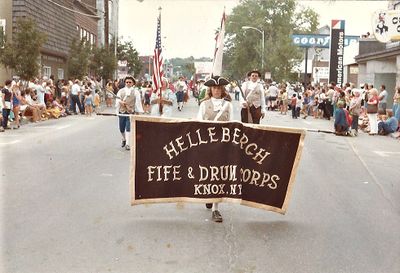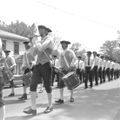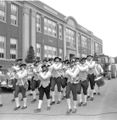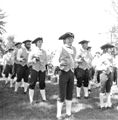HELLEBERG FIFE & DRUM CORPS
HELLEBERGH FIFE AND DRUM CORPS Knox, NY
In late 1975, as the Hilltowns were preparing to celebrate the country’s Bicentennial year, Dan Driscoll approached the Knox Volunteer Fire Company with a proposal to use the Fire Company’s drum corps as the nucleus of a fife and drum corps. The idea was to form a musical group to provide historically authentic entertainment for Bicentennial events. The Fire Company agreed.
Beginning in October 1975, interested students and adults were given fife lessons at the Firehouse. By early 1976, the enthusiastic new group had grown to 19 fife players and 6 drummers. On January 4, 1976 the Knox Fife and Drum Corps was organized; officers included: Paula Shafer, president; Tom Gutkoska, vice president; Rev. Peter Berry, secretary; Sandra Quay, treasurer; and Dan Driscoll, music master.
Other original members were Bryan Wukits (quartermaster), Karen and Jim Beil, Kim Decker, Chris Farmer, Walt Farmer, Debbie McDermott, John McDermott, Bob Moons, James Neese, Jill Norray, Jeff VanEtten (drum sergeant), Judy VanEtten, Terri Ward, Martha Whipple, Ron Quay, Bob Stevens, Jeff Landauer, Dave Shafer and Dana Sherman.
Because the Corps’ members came from the communities in and around the Helderberg Mountains, not just from Knox, the Corps’ name was quickly changed. In choosing the name it was felt that Hellebergh, the original Dutch spelling of Helderberg, was more in keeping with the historical emphasis of the Corps.
Despite the fact that none of the members had any corps experience, the Hellebergh Corps had few organizational problems. Their sponsors, the Knox Volunteer Fire Co., provided the drums, the neighboring Delmar Village Volunteer Fife and Drum Corps provided the know-how, and local businesses provided materials for making uniforms.
The Corps combined two historic periods in its uniforms and music: the American Revolutionary period and New York’s anti-rent war period (1840’s). The fifers and drummers wore Revolutionary style uniforms of tan waistcoats and dark breeches. The “Calico Indian Militia,” which paraded with the Corps, wore authentic disguises of the anti-rent war period, blew tin horns used to assemble the anti-rent protestors, and carried the type of weapons used by the protestors. With its dual focus, the Corps’ repertory included not only songs that were popular during the American Revolution, but a number of anti-rent tunes published in broadsides during the 1840s.
The anti-rent wars in the Helderberg Mountains were considered by many of those involved in the struggles to be a continuation of the Revolutionary War. Farmers were required to pay rent many times the value of their land to Patroons, without hope of ever owning their own land. Attempted legal solutions were ineffectual; the result was armed resistance by “Calico Indians,” farmers wearing disguises in the spirit of the Boston Tea Party.
Fifes and drums were used at the meetings and drills of the Calico Indians. In the words of author Henry Christman from his book Tin Horns and Calico, “the masked army tramped over the broad meadow to the strains of ‘Old Dan Tucker’ played upon a single fife and accompanied by a small drum.” On another occasion, “suddenly a rolling tattoo sounded on the drums, a fife shrilled and the crowd fell silent.” At a signal from the chief of the Indians, “the instruments took up the strains of ‘Old Dan Tucker’, and he led the tribesmen in war song, with its robust chorus of ‘Get out of the way, Big Bill Snyder, We’ll tar your coat and feather your hide, sir!’” (an anti-rent adaptation of “Old Dan Tucker.”)
Although the Corps was formed to provide music at Bicentennial events, due to its popularity, it continued to grow after the Bicentennial year. It typically performed at ten to fifteen events each year, including Memorial Day parades, firemen conventions, and fife & drum corps gatherings called musters. With its earnings from “away” events, the Corps was soon able to buy traditional “rope tensioned” drums; by early 1978 the Corps owned three bass drums and six snare drums.
The Corps was indebted to Walt Farmer, its drillmaster for training the Corps members to step sharply. As a result of his efforts, the Corps frequently won first-place trophies.
By late 1978, the Corps was sufficiently well known that it sponsored a Fife and Drum Corps Muster in connection with Knox Community Day, inviting five other corps from New York and Vermont. The Sept. 30 Community Day was organized jointly by the Knox Historical Society, the Knox Volunteer Fire Company, the Helderberg Kiwanis Club and the Hellebergh Fife and Drum Corps. As part of the event, the Corps’ Calico Indians re-enacted the tar & feathering of the anti-rent period deputy sheriff Big Bill Snyder.
By 1983 the Corps had over 30 members and more than 30 former or inactive members. However, as memories of the Bicentennial year faded, membership gradually dropped. Eventually the Corps disbanded, and the drums and several uniforms were donated to the Knox Historical Society. On July 9, 2006, former members of the Corps gathered at the Knox Museum (Saddlemire Homestead) for the 30th year reunion to relive the wonderful experience that was the Hellebergh Fife and Drum Corps.
Photos:
FifeDrum5 –
FifeDrum6 –
FifeDrum9 – The Hellebergh Fife and Drum Corps gets ready to march, with the Calico Indians in the last row.
FifeDrum10 – The Hellebergh Fife and Drum Corps marches in the Knox Community Day Parade. In the front row are Roger Keenholts, Joyce Moons, Yvonne Farmer (carrying the “Down with the Rent” flag), and Rev. Peter Berry
FifeDrum13 – Drillmaster Walt Farmer leads the Hellebergh Fife and Drum Corps at the Knox Community Day and Fife & Drum Muster September 30, 1978.
D.A.Driscoll, 4 August 2012
HELLEBERG FIFE & DRUM CORPS - – At the Altamont Fair Grounds, Amy Osterhout and Michelle Klein stand in the front row in Calico Indian costumes; Amy is holding drummer Erica Driscoll’s hand. Behind them is Dan Driscoll with the bass drum, and Bill and Rob Moons and Chris Farmer with snare drums. - Photo courtesy of Dan Driscoll








































